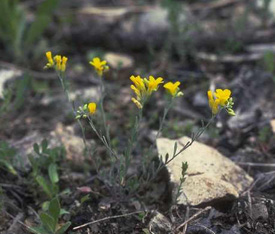Physaria filiformis facts for kids
Quick facts for kids Physaria filiformis |
|
|---|---|
 |
|
| Conservation status | |
| Scientific classification | |
| Genus: |
Physaria
|
| Species: |
filiformis
|
| Synonyms | |
|
Lesquerella filiformis Rollins 1956 |
|
The Physaria filiformis, also known as the Missouri bladderpod or limestone glade bladderpod, is a rare flowering plant. It is found naturally in the states of Missouri and Arkansas in the United States. This plant was first listed as an endangered species in 1987, meaning it was in danger of disappearing forever. However, its situation improved, and in 2003, its status was changed to "threatened," which means it is still at risk but less so than before.
Contents
About the Missouri Bladderpod Plant
The Missouri bladderpod is an annual plant, which means it completes its entire life cycle in one year. It grows several thin, branching stems that can reach up to 25 centimeters (about 10 inches) tall. These stems can grow straight up or droop down.
Plant Features
The leaves of the plant come in different shapes. The leaves at the bottom of the plant can be up to 2.4 centimeters (almost an inch) long. Its flowers are pale yellow and grow in a cluster called a raceme. Each petal is about half a centimeter to nearly one centimeter (0.4 inch) long. After flowering, the plant produces a round fruit called a silique.
Life Cycle of the Bladderpod
This plant is a "winter annual." This means its seeds sprout in the fall, and the plant forms a small cluster of leaves close to the ground. Then, in the following spring, it grows its stems and flowers. The tiny seeds are spread by the wind and by water running over the ground.
Where the Missouri Bladderpod Lives
The Physaria filiformis plant grows in special places called limestone glades and on bare rock outcrops. These areas are mostly found in southwestern Missouri and northwestern Arkansas.
Bladderpod Habitat
The areas around these glades might be prairies or pastures. Sometimes, different types of forests are right next to the glades. The soil on these glades is very shallow, so not many other plants can grow there. The Missouri bladderpod grows less often in places with deeper soil and more plants. This is probably because other plants compete with it for space and nutrients.
Important Factors for Growth
The plant also doesn't grow well in shady areas, like under Juniperus virginiana (cedar) trees. Sunlight is very important for its growth. The Missouri bladderpod can be found in many different small areas within its habitat. This variety helps in protecting and managing the plant.
The Role of Wildfire
Wildfires are very important for keeping the limestone glade habitat healthy. Fires help keep these areas open and free of large trees and bushes that would block sunlight from reaching small plants like the bladderpod. Fire stops the natural process where open land slowly turns into a forest. Other plants that live in these glades include Arenaria patula, Camassia scilloides, Nothoscordum bivalve, Opuntia humifusa, Satureja arkansana, Tradescantia tharpii, and Verbena canadensis.
Protecting the Missouri Bladderpod
The health of the local ecosystem depends on natural fires. However, when people stop fires from happening (called fire suppression), the habitat can get damaged. Without fire, woody plants grow in, covering the glades and blocking the sunlight that the bladderpod needs. This growth of other plants is a major threat to the species.
Threats to the Plant
Other dangers to the Missouri bladderpod include off-road vehicles driving through its habitat, limestone mining, and new buildings from urban development. Also, invasive species of plants, like Bromus tectorum (a type of grass), have been brought into the habitat and compete with the bladderpod. The plant can handle some light disturbance, like animals eating it or people walking on it, so these are not major threats.
Conservation Efforts
When Physaria filiformis was first listed as endangered, there were only nine known groups of the plant. After many surveys, more groups were found. Many of these areas are now protected by organizations like the National Park Service and The Nature Conservancy. By 2003, there were about 60 known groups, and the plant's future looked much better, which is why its status was changed to "threatened."
Most of the Missouri bladderpod plants are found in southwestern Missouri. A large group of them lives at Wilson's Creek National Battlefield. To help protect the plant, people are working to keep its habitat safe in public areas. They also use prescribed burns, which are controlled fires, to bring back the natural fire patterns. Reducing the use of herbicides (chemicals that kill plants) also helps protect this special plant.


